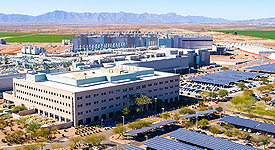
What is stormwater? Stormwater is runoff, and surface flows are generated from rainfall events.
The city's Stormwater Program helps educate the community on environmental regulations. Chandler works with state and federal regulators to make sure residents understand the effects of stormwater drainage and how to reduce pollutants in the storm drain system.
The city offers free presentations about stormwater pollution prevention for schools, community groups, homeowners and neighborhood associations.
When it rains in urban areas, the stormwater runs off buildings and paved areas instead of soaking into the ground. The stormwater collection system, also known as the storm drain system, is designed to move stormwater flows along conveyances like city streets and gutters where it is directed into storm drains or spillways constructed along the street, and eventually deposited into retention basins, greenbelt areas, parks and lakes within the community.
No. The stormwater collection system is completely separate from the sanitary sewer system connected to our homes and businesses. The sanitary sewer system delivers wastewater from our sinks, showers, toilets, and washing machines to a wastewater treatment facility where the wastewater is treated and either reused or recharged to groundwater. Stormwater runoff collected in stormwater collection systems is not treated before it infiltrates to groundwater or is discharged to retention basins, greenbelt areas, parks and lakes within the community.
Common pollutants found in stormwater may include but are not limited to, pesticides, fertilizers, litter, pet waste, petroleum products, automotive fluids, paints, solvents, yard waste, sediment, chemicals, and other materials.
Report flooding, stormwater issues, illicit dumping/discharge, standing water or pool drainage.
- Brochure: What You Can Do to Reduce Stormwater Pollution?
- Stormwater Outreach for Regional Municipalities
- Pool Drainage Requirements
- Chandler City Code - The City has a couple chapters in the City Codes that address discharges of pollutants into the storm drain system. For more information, review the Code in chapters 30 and 45.
- Arizona Department of Environmental Quality - Stormwater Permitting
- Maricopa County Flood Control District
Resources for the Construction Industry
Resources for Industrial Facilities
- Arizona Department of Environmental Quality Mining Multi-Sector General Permit Requirements
- Arizona Department of Environmental Quality Non-Mining Multi-Sector General Permit Requirements



